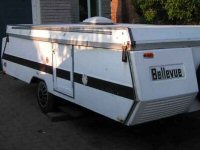Again, I'm confused?????
23 posts
• Page 2 of 2 • 1, 2
The nice thing about this forum it we get to present different ideas. The bottom line here is that there is more than one way to do things right. I guess a lot would depend on the layout of a given trailer. Based on what I have read here there are plenty of different ideas on how to lay things out and what works best. For me, most of my electrical is going to be in the back of the trailer as that is where the need is. I will be running two inverters, one in the back that will be hard wired to the batteries. The other one will be in the front of the trailer to run the "entertainment center". This device will need a standard 12v outlet. Since I will need to run two 12 ga wires to the front (one positive and one negative) and those wires will run right past my cabin lights, why not switch the negative wire to 10 ga and eliminate two wires. Running multiple negative wires side by side just doesn't make sense to me. If you folks like it, no problem, for me it's just a waste of good wire. As for problems down the road I have a very simple approach to things like this. Do it once, do it right, never worry about it again.
-

BPFox - Teardrop Master
- Posts: 293
- Joined: Sun Apr 06, 2008 12:41 pm
- Location: Saginaw, MI
BPFox wrote:I will be running two inverters, one in the back that will be hard wired to the batteries. The other one will be in the front of the trailer to run the "entertainment center". This device will need a standard 12v outlet. Since I will need to run two 12 ga wires to the front (one positive and one negative) and those wires will run right past my cabin lights, why not switch the negative wire to 10 ga and eliminate two wires. Running multiple negative wires side by side just doesn't make sense to me
So long as the wires are adequately sized, that would certainly work and it will be safe as well . . . . but it's not the way I would do it. Likely you're not really saving any money or wire either, because the difference in weight and cost of a 10 gauge wire compared to a 12 gauge wire is likely about the same as using a 12 gauge wire along with a dedicated 16 gauge wire as a ground for your cabin lights . . . . you might actually be using more copper than if you had run a dedicated wire for your cabin lights gound
Using the ground wire of a high current device (the inverter) to ground the cabin lights will have your cabin lights 'flickering' when the inverter is in use and drawing current through it's gound wire - The higher the load on the inveter, the dimmer the cabin lights and if the inverter load varies, so will the intensity of the cabin lighting. While it may be safe, it's still not the advisable way to go
Another disadvantage is that later on down the road, if you ever experience electrical problems of any kind it will be much harder to troubleshoot them because you don't have all of the connections available in one place . . . . you have ground connections scattered all over the trailer - That doesn't strike me as doing it 'right'
On a DIY project, like a teardrop trailer, the builder is free to engineer most things any way he likes and since your method is safe so far as I can tell, there's nothing wrong with you using it but I would hesitate to recommend to anyone else to just daisy chain their ground wires together without carefully examining what the loads are, which ones will be running at the same time and what the various voltage drops are likely to be.
As a general rule, you shouldn't share the ground wire of any high current device (like an inverter) with other circuits, like lighting or fans. For the average guy who can't or doesn't care to go through all of evaluation necessary, individual grounds are the safe and predictable way to go . . . . and I would never go so far as to tell anyone that they are 'unnecessary' or a waste of money or wire
But . . . . we all get to do it pretty much any way we like, so it's all good

Don
-

Alphacarina - 500 Club
- Posts: 826
- Images: 4
- Joined: Tue Jun 19, 2007 3:26 pm
- Location: Ocean Springs MS



